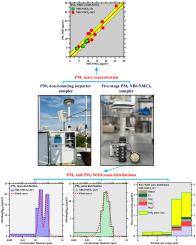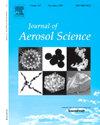用于 PM1 质量测量的单级 NBI 采样器和用于 PM1 质量分布测量的五级 NBI-NMCI 采样器
IF 3.9
3区 环境科学与生态学
Q2 ENGINEERING, CHEMICAL
引用次数: 0
摘要
近年来,人们对与 PM1 颗粒相关的健康和环境风险的关注与日俱增。然而,现有的 PM1 采样仪器仍有待改进,主要是因为其 PM1 入口存在颗粒负载和反弹问题。为了应对这些挑战,我们开发了基于无反弹冲击器(NBI)技术的 PM1 入口。这些入口采用真空油浸湿玻璃纤维过滤器(GFF)基板来消除颗粒反弹,并结合每日真空注油来防止颗粒负载。16.7 升/分钟的 PM1 NBI 是在 PM2.5 M-WINS 设计的基础上改进而来的,单个喷嘴的直径有所减小,其设计目的是为了便于与当前的标准采样和监测系统相匹配。通过考虑雷诺数以及射流到板的距离和喷嘴直径之比的影响,确定了 0.99 ± 0.02 μm 的切割尺寸(Dpa50)。将 16.7 升/分钟 PM1 NBI 采样器与 9 级 NCTU 微孔级联冲击器(NMCI9)进行比较的现场测试表明,当在 NMCI9 中使用硅油涂层铝箔(AF)和 GFF-AF 时,PM1 测量值的平均差异为 +0.26 ± 2.28 μg/m3 ,采样偏差较小。使用油浸湿 GFF 基底的 NBI 能有效去除大于 1.0 μm 的颗粒,从而获得更准确的 PM1 质量浓度测量结果。此外,以 30 升/分钟的 PM1 NBI 作为第一级,开发出了 5 级 NMCI,从而能够在两种模式下详细测量 PM1 的质量分布,这对于测量环境气溶胶的整个质量分布具有挑战性。PM1 中与尺寸相关的水溶性无机离子的分布表明,与 PM2.5 相比,PM1 中的 SO42- 和 NH4+ 占主导地位。总之,PM1 NBI 通过解决颗粒负载和反弹问题,提高了长期大气采样的准确性,使其成为更可靠的标准采样仪器。本文章由计算机程序翻译,如有差异,请以英文原文为准。

Single-stage NBI sampler for PM1 mass and five-stage NBI-NMCI sampler for PM1 mass distribution measurements
In recent years, concerns about the health and environmental risks associated with PM1 particles have increased. However, existing PM1 sampling instruments remain to be improved mainly because their PM1 inlets have particle loading and bounce issues. To address these challenges, PM1 inlets based on the Non-Bouncing Impactor (NBI) technique were developed. These inlets employ vacuum oil-wetted glass fiber filter (GFF) substrates to eliminate particle bounce and incorporate a daily vacuum oil injection to prevent particle loading. The 16.7 L/min PM1 NBI, modified from the PM2.5 M-WINS design with a reduced diameter of the single nozzle, was designed to adapt readily with current standard sampling and monitoring systems. The cut-size (Dpa50) of 0.99 ± 0.02 μm was determined by considering the effects of Reynold number and the ratio of jet-to-plate distance and nozzle diameter. Field tests comparing the 16.7 L/min PM1 NBI sampler to the 9-stage NCTU Micro-orifice Cascade Impactor (NMCI9) revealed small sampling biases, with a mean difference of +0.26 ± 2.28 μg/m3 for PM1 measurements when silicone oil-coated aluminum foil (AF) and GFF-AF were used in the NMCI9. The NBI with the oil-wetted GFF substrate effectively removed particles larger than 1.0 μm, resulting in more accurate PM1 mass concentration measurements. Additionally, the development of a 5-stage NMCI with the 30 L/min PM1 NBI as the first stage enabled detailed measurement of PM1 mass distribution in two modes, which was challenging when measuring the entire mass distribution of ambient aerosols. The distribution of size-dependent water-soluble inorganic ions in PM1 showed dominance of SO42− and NH4+ in PM1 compared to PM2.5. In summary, the PM1 NBI enhances accuracy for long-term atmospheric sampling by addressing particle loading and bounce, making it a more reliable standard sampling instrument.
求助全文
通过发布文献求助,成功后即可免费获取论文全文。
去求助
来源期刊

Journal of Aerosol Science
环境科学-工程:化工
CiteScore
8.80
自引率
8.90%
发文量
127
审稿时长
35 days
期刊介绍:
Founded in 1970, the Journal of Aerosol Science considers itself the prime vehicle for the publication of original work as well as reviews related to fundamental and applied aerosol research, as well as aerosol instrumentation. Its content is directed at scientists working in engineering disciplines, as well as physics, chemistry, and environmental sciences.
The editors welcome submissions of papers describing recent experimental, numerical, and theoretical research related to the following topics:
1. Fundamental Aerosol Science.
2. Applied Aerosol Science.
3. Instrumentation & Measurement Methods.
 求助内容:
求助内容: 应助结果提醒方式:
应助结果提醒方式:


